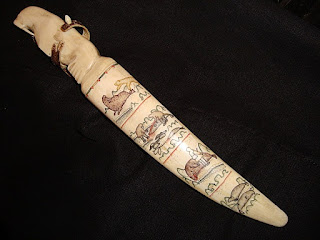Chukotka is one of these Russian Arctic regions that have been for long forgotten and abandonned to their native subsistence way of living. Only recently has Russia started to look more carefully to its far east Arctic Coast, as the Northwest Passage is now more frequently navigable - thanks to the warming ! - and the underground is found rich in deposits of gas and petroleum.
It's almost unbelievable how people have resisted living for centuries on these desolate and unfriendly tundra territories, far from any civilised town, under Arctic cold, on freezed land and ice covered seas. Some time ago I reported in Ultima Thule on the native village of Uelen; Inchoun is located nearby to the West, also on a sand spit by the sea.
Between Inchoun and Uelen, the only transport in winter used to be dogsled.
Arriving to Inchoun by sea, a row of low wooden cabins on a sand spit welcomes the visitors.
Old isbas (left), soviet era cabins, and the new school (right).
Coordinates: 66° 18′ N, 170° 17′ W
(north of the arctic circle and close to the date line).
Population: ~ 420
Snowmobiles are the top choice for moving on the ice, though dogsleds are still much in use.
Inchoun's main road.
The oldest isbas are poorly built log cabins.
Locals mainly live now in new, heated cabins. But construction materials are always desperately needed for repairing.
The village's facilities include school, medical center, a small library, a post office, bakery, public bath and laundry facility, a small store. Power supply is provided by the village local diesel power.
Water supply is probably still the main difficulty. Truck-trains run along icy roads to bring tje precious supply.
The local shop, also a recent improvement, as fresh supplies arrive more frequently than it used to be.
Girls wearing the traditional 'Kamleya' summer dress.
Amazingly, the vilage is growing and those many children eventually obtained a brand new school.
Marine hunting has always been part of everyday life in Inchoun. The other main occupation is reindeer herding.
Inspired in a reversed boat, probably, the new school is the best improvement of all - it became the centre of social and cultural life in the village.
ДРУЖБА, friendship
The achitecture intends to allow snow to slide down easily leaving he roof clear.
The name of the village comes from the Chukchi word I'nchuvin, meaning "a cut-off nose tip".
This strange appellation is derived from a nearby cliff with a tall rock at its base that is said to look like a nose cut from the cliff.
Beringiya festival - the Beringian Arctic Games
http://beringiagames.com/
The Beringyia Festival was held for the first time in 1992 in order to preserve traditional sports and national, as well as marine hunters culture.
One of the most popular games - tug of war.
In Agust, there is a celebration holiday, when artists from the surrounding towns -Anadyr, Uelen, Lawrence, Enurmino, Chaplin, Lorino,... - organize a program of music and dance festivities, a display of carving arts, taditional skin clothes and other crafts, traditional games, dogsled races, local dishes, and the main event - the hunter's regatta.
Marine mammal ivory carving is one of the native crafts.
The regatta annualy atracts many hundreds. Inchoun is one of the towns with a local program, and a hunter's boat race takes place there each year in the interior lagoon of the spit.
Marine hunters race on the Chukchi-Yup'ik eskimo canoes.
The regatta has been held for more than 20 years - the first one was held in 1992.
And women too !
Winds and blizzard are almost always present, even when the sun makes some way through them.
The main goal is not only to preserve the skills in manufacturing and manoeuvering leather built canoes, but also to collect from all over the coast guests of rowers teams.
-----------------------
Marine hunters returning after a day hunting in the lagoon (2003)
Inchoun cliff in winter.
Dimmed midnight sun over Inchoun.




































